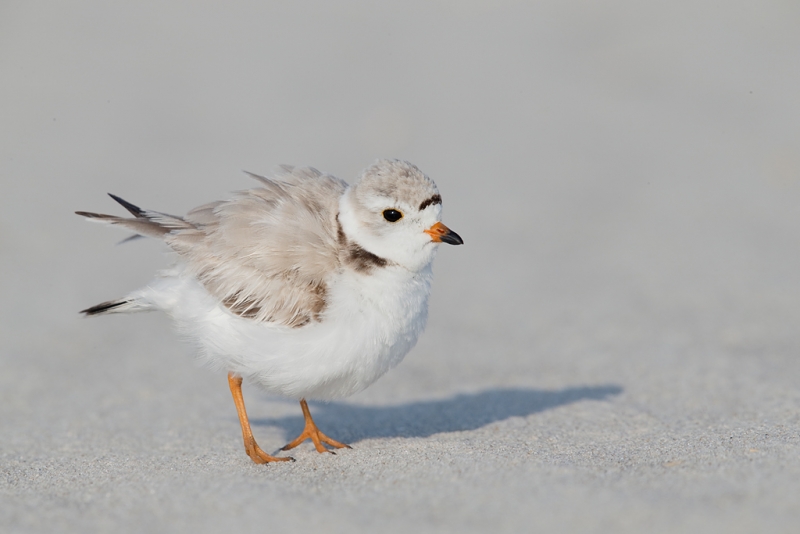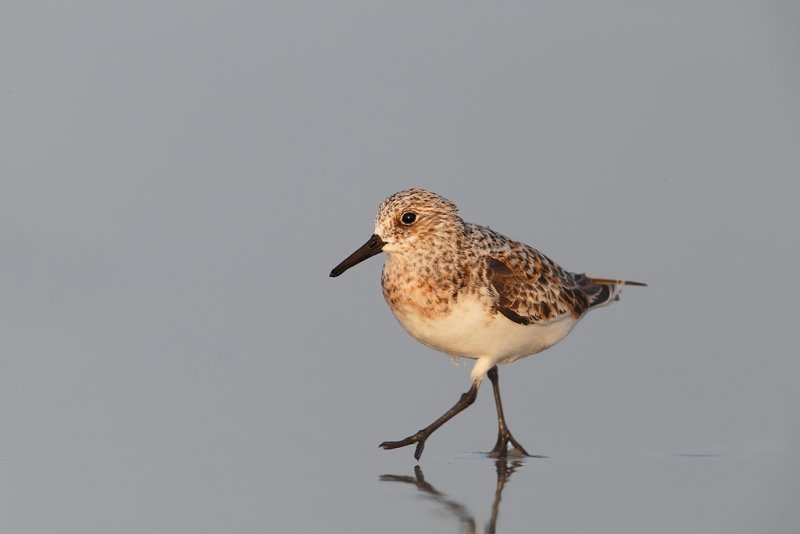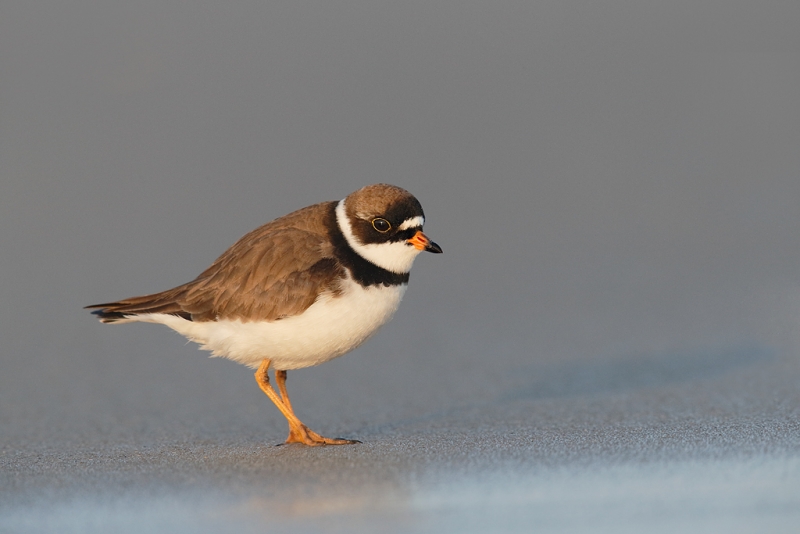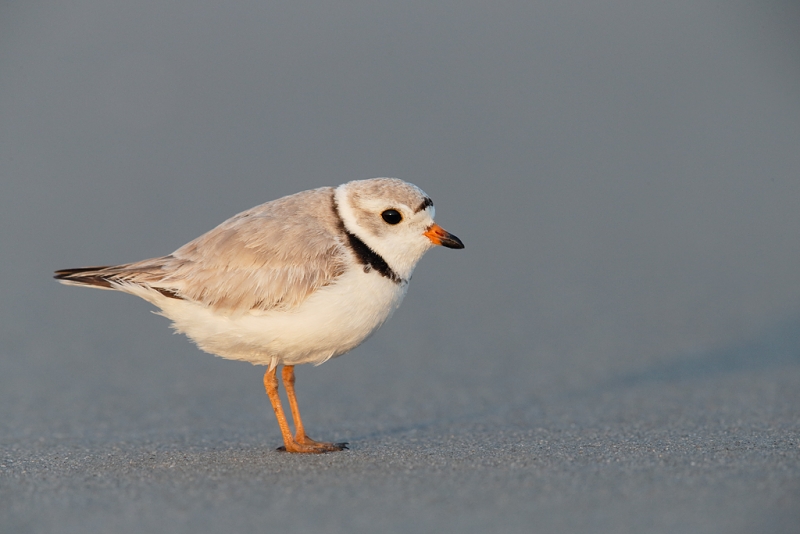|
This female Piping Plover image was created with the tripod-mounted Canon EF 600mm f/4L IS II USM lens, the Canon 2x EF Extender III (Teleconverter), and the Canon EOS-1D X Digital SLR camera. ISO 400. Evaluative metering -1/3 stop: 1/500 sec. at f/13 in Manual Mode. Central sensor (by necessity) Expand/AI Servo/Rear Focus on the leading edge of the neck band active at the moment of exposure. Click here if you missed the Rear Focus Tutorial. Click on the image to see a larger version. |
Before the Mayhem Started
Up until I witnessed the violence and murder at Nickerson Beach on Monday afternoon past–click here if you missed that–it had been a peaceful afternoon. The female plover above was walking around near her predator exclosure picking at small items on the sand so I sat down near the ropes at the edge of the colony and created a few images as she made her way back to the nest. Plovers are always step, step, step, stop; step, step, step, stop; and the stops are not long ones. The only way to successfully acquire focus was to pre-focus manually as I followed and framed the image. When the bird would stop I would do my best and make an image or two. In this case, four as the bird paused to ruffle its feathers.
|
This running Sanderling image was created with the tripod-mounted Canon EF 600mm f/4L IS II USM lens, the Canon 2x EF Extender III (Teleconverter), and the Canon EOS-1D X Digital SLR camera. ISO 800. Evaluative metering -1/3 stop: 1/800 sec. at f/9 in Manual Mode. Central sensor (by necessity) Expand/AI Servo/Rear Focus on the bird’s neck active at the moment of exposure. Click here if you missed the Rear Focus Tutorial. Click on the image to see a larger version. |
Surf Strategies
After working the plover for a while I headed down to the surf to work the foraging shorebirds. The sun was coming over my left shoulder as I was seated facing east/southeast behind my lowered tripod. With the wind fairly strong from the south the birds that were following the receding waves to feed were heading straight south into the wind and were actually angling away from me and away from the light. When a wave broke the birds would run back up the beach. This was a much better situation as they were running toward me and into the light. The problem was that acquiring and maintaining focus on a speeding Sanderling with the 600 II and the 2X III TC was pretty much impossible even with the vaunted 1D X. Until I pulled an old trick out of the box. I changed my setting for Focus Search On and found that with the AF system instructed not to hunt thatif I prefocused manually and followed the running birds that it was much, much easier to acquire and maintain accurate focus.
With all due respect to the 1D X camera body manual and the Info stuff on the camera what folks are being told makes zero sense. If you would like to learn when and how to set and use the Focus Search custom function you will need a copy of our 1D X AF Guide. 5D Mark III and 1D Mark IV owners will need the camera specific guide for each of these bodies. Learn more here.
|
This Semipalmated Plover image was created with the tripod-mounted Canon EF 600mm f/4L IS II USM lens, the Canon 2x EF Extender III (Teleconverter), and the Canon EOS-1D X Digital SLR camera. ISO 1600. Evaluative metering -2/3 stop: 1/1000 sec. at f/9 in Manual Mode. Central sensor (by necessity) Expand/AI Servo/Rear Focus on the base of the bird’s bill and release. Click here if you missed the Rear Focus Tutorial. Click on the image to see a larger version. |
Killer Sweet Backgrounds
The big attraction in the both the image above and the image below was the killer clean, wet sand backgrounds. I forgot to mention when I posted this on Thursday night that a large part of my “surf strategy” involved scoping out a really clean stretch of beach and then simply sitting in one place for extended periods and waiting for the birds to come to me. When I first sat down it was all Sanderlings, but with patience the two plover species came by for brief visits. As both piping and semipalmated are quite skittish, stalking them is quite difficult if not impossible.
Those who would like to learn more about shorebirds are advised to get a copy of my “Shorebirds; Beautiful Beachcombers.” It is twice out of print and is selling for as much as $75 on e-Bay and Amazon. And we are down to a precious few copies….
|
This male Piping Plover image was also created with the tripod-mounted Canon EF 600mm f/4L IS II USM lens, the Canon 2x EF Extender III (Teleconverter), and the Canon EOS-1D X Digital SLR camera. ISO 1600. Evaluative metering -2/3 stop: 1/640 sec. at f/10 in Manual Mode. Central sensor (by necessity) Expand/AI Servo/Rear Focus on spot where the breast band meets the neck active at the moment of exposure. Click here if you missed the Rear Focus Tutorial. Click on the image to see a larger version. |
Your Favorite
Take a moment to leave a comment and let us know which of the images above is your favorite. And why. Be sure to click on each image to see the larger version.
More Short Notice, Dirt Cheap, Small Group, In-the-Field Nickerson Beach Photographic Instruction with Arthur Morris. May 27 (am & pm), May 28 (am & pm) and May 29 (am only). All 2013 of course. Morning sessions: 5am sharp-9:30 am. Afternoon sessions: 4pm til whenever. These are priced so low that you need to e-mail for the rates. Limit 5/session.
If you e-mail, please include all phone numbers. Payment in full due immediately via credit card after calling the office on a weekday: 863-221-2372. If you would like to join me, please get in touch via e-mail. Breeding American Oystercatcher (chicks likely) and Piping Plover (chicks possible). Common Tern and Black Skimmer/courtship behaviors. Herring and Great Black-backed Gulls. Breeding plumage Sanderling and other shorebird species. Lots of flight photography when the wind is right. Learn digital exposure and creative image design. Learn to create pleasing blurs at 5am.
Nickerson Baby Beach-nesting Birds IPT: July 23-25, 2013: $1099. Introductory slide program: Monday, July 22, 2013. Limit 12/Openings: Sold Out. Co-leader: Denise Ippolito.
IPT Info
For complete IPT info including schedule, cancellation policies, and the registration and release forms, click here.
It’s Not Too Late! New York City–On Location with Denise Ippolito & Arthur Morris May 25 – 26, 2013, 2-day Workshop-$495
Join Denise Ippolito and Arthur Morris for a two-day creative workshop in the Big Apple. This exciting adventure through the streets of NYC will begin with an informal get-together at our hotel on the evening of May 24th. This will give us all a chance to get to know each other before we hit the streets in the morning for our first exciting photo shoot. We will explore China Town, Little Italy, Times Square, Rockefeller Center, Grand Central Station (tripod permit included) and much more during our two days together. The emphasis will be on street photography, seeing and capturing dynamic images, and expanding your creativity using a variety of in-camera techniques including HDR and Multiple Exposure.
Please contact me via e-mail for complete details and the itinerary.
Next Year In Holland
Despite a 100-year record cold spring with very few tulip fields in bloom this trip has been a spectacular success. The colors and variety of tulips at Keukenhof simply stun the mind and the senses. Denise and I are planning our Holland trip for next year: the Keukenhof Creative Tulip Photography IPT with a Touch of Holland. If you are a Happy Camper who is interested in joining Denise and me next spring, please shoot me an e-mail. Details will be announced soon.
We are currently fleshing out the details. The dates will be about the same, in mid April. In addition to the Keukenhof and the flower fields we will do an afternoon of windmills at Kinderdijk, a day in Amsterdam including a morning at the Rijks Museum and an afternoon visit to the Ann Frank House plus some street photography. We will do some street photography and fine dining in the little town of Edam. There will be about 7-9 days of photography in all. Those will include an afternoon option for a day or two of Purple Herons for those with long lenses.
Note: not surprisingly, early interest has been huge with several folks who want to sign up right now. The formal announcement of the dates and price is imminent.
Typos
On all blog posts, feel free to e-mail or leave a comment regarding any typos, wrong words, misspellings, omissions, or grammatical errors. Just be right. 🙂
Support the BAA Blog. Support the BAA Bulletins: Shop B&H here!
We want and need to keep providing you with the latest free information, photography and Photoshop lessons, and all manner of related information. Show your appreciation by making your purchases immediately after clicking on any of our B&H or Amazon Affiliate links in this blog post. Remember, B&H ain’t just photography!




Support the Blog


Amazon
Everyone buys something from Amazon, be it a big lens or deodorant. Support the blog by starting your search by typing in the little white box below. No purchase is too small to be appreciated; they all add up. Why make it a habit? Because I make it a habit of bringing you new images and information on an almost daily basis.
And from the BAA On-line Store:
LensCoats. I have a LensCoat on each of my big lenses to protect them from nicks and thus increase their re-sales value. All my big lens LensCoat stuff is in Hardwood Snow pattern.
LegCoat Tripod Leg Covers. I have four tripods active and each has a Hardwood Snow LegCoat on it to help prevent further damage to my tender shoulders 🙂 And you will love them in mega-cold weather….
Gitzo GT3532 LS CF Tripod. This one replaces the GT3530LS Tripod and will last you a lifetime. Learn more about this great tripod here.
Mongoose M3.6 Tripod Head. Right now this is the best tripod head around for use with lenses that weigh less than 9 pounds. For heavier lenses, check out the Wimberley V2 head.
Double Bubble Level. You will find one in my camera’s hot shoe whenever I am not using flash.
The Lens Align Mark II. I use the Lens Align Mark II pretty much religiously to micro-adjust all of my gear an average of once a month and always before a major trip. Enjoy our free comprehensive tutorial here.
BreezeBrowser. I do not see how any digital photographer can exist without this program.
Delkin Flash Cards. I use and depend on Delkin compact Flash Cards and card readers most every day. Learn more about their great 700X and 1000X cards here or about my favorite Delkin card here.


















For me it’s a toss-up between the Piping and Semipalmated plovers. The clarity, vibrance, sharpness, DoF, backgrounds, poses and head angles are wonderful. Great work and thanks for sharing!
Artie…the link to your book is going to Art of Bird Photography, not the
Beachcombers one.
Doug
Thanks Doug. I fixed it.
Looks like you really killed it with the Plovers!! They are definitely tough to get a lock on…
Thanks Charles. See my additional “surf strategy” comments in the Killer Sweet Backgrounds paragraph.
These are incredibly wonderful photos. Thanks for sharing the images and your explanations and ideas. Hard to choose a favorite, but if I had to, it would be #1. I really like the “action” of that shot (the ruffling of the feathers), and the wonderful colors. I love the clean sand in all the shots and how there is no perceptible horizon line. Also love the DOF on all. Awesome shots, Artie!
Semipalmated plover for me.
– killer background
– partially raised foot
– love the clean water edge on the bottom
– one of my favorite birds 🙂
Some really sweet images here with killer, clean backgrounds